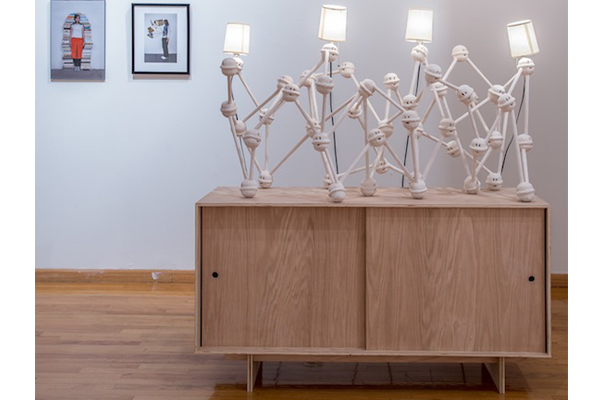
Photograph: Courtesy of Center for Books and Paper
Eva Kotatkova and Sterling Lawrence
Three current exhibitions at the Columbia College galleries are exciting not only because they present inventive, thematic shows, they also are highly interactive (visitors are asked to play with the art on view and buy prints and posters for a small price).
Structures for Reading at the Center for Book & Paper Arts
This smartly curated and timely exhibition proposes experimental commercial applications and artist-made objects related to reading. For example, Gareth Long and Sebura & Gartelmann’s two-person desk was inspired by a description of a two-person desk in Flaubert’s last novel Bouvard and Pécuchet and artist Sterling Lawrence’s jungle-gym lamp. It would be a perfect addition to a kid’s room. Sculptures, drawings, altered books, and other conceptual designs for new reading technologies round out this engaging exhibition, with work by more than a dozen makers. Through April 6 at 1104 S Wabash, second floor.
Rube Goldberg’s Ghost at the Glass Curtain Gallery
This highly interactive, hands-on exhibition is informed by the legacy of Rube Goldberg (1883–1970), an engineer and cartoonist who conceived of “machines” made from everything-but-the-kitchen-sink materials. This group show is packed with newfangled machines that riff on Rube and, moreover, reassert the machines as he originally conceived them: as parodies of the political process. Mark Porter plays with notion of “laborious” machine operation in his dumb-acting mechanisms that spit paint on the walls. Michael Thompson’s machine, or a hand-cranked masturbation, is equally playful. In fact, there’s a lot of hand-cranking in this exhibition, which makes it an unusually fun experience for an art gallery. With artworks by nearly 20 artists, the show is a perfectly cramped carnival of grandiose distractions. Through May 4 at 1104 S Wabash.
Market Value: Examining Wealth and Worth at A+D Gallery
In the popular press, the question of contemporary art’s fiscal value usually precedes questions of art’s intellectual value. This exhibition, with work by 13 artists, foregrounds this concern and embeds it within the art objects themselves, all of which are for sale through an online bidding platform or as cash-and-carry objects. Chad Person made collages reshaping actual paper money into calligraphy; Jason Polan’s Three Dollar $2 Bill is a risograph print that plays with the inflated value of currency; the wry posters by William Powhida give Tips for Artists Who Want To Sell. The illuminating catalog essay by Monica Westin is not to be missed. Through April 20 at 619 S Wabash.


